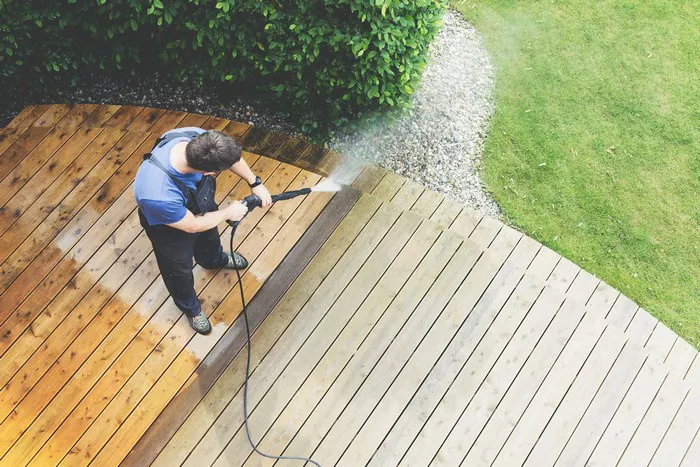Pressure washing is one of the most effective ways to clean a home’s exterior. It removes dirt, mildew, and grime, restoring surfaces to their original appearance. However, selecting the right pressure setting is crucial to ensure effective cleaning without causing damage.
This article explores the ideal PSI (pounds per square inch) for pressure washing a house, the factors to consider when choosing the correct PSI, and tips for safe and effective cleaning.
Understanding PSI in Pressure Washing
What Does PSI Mean?
PSI stands for pounds per square inch, which measures the pressure of water coming from a pressure washer. The higher the PSI, the more forceful the water stream.
Low PSI settings are suitable for delicate surfaces like wood siding, while high PSI settings are better for tough stains and hard surfaces like concrete.
Why PSI Matters
Choosing the correct PSI is essential for cleaning efficiency and safety. Using too little pressure might not clean effectively, while too much pressure could damage the surface you are cleaning.
Recommended PSI for Different Parts of a House
The optimal PSI for pressure washing depends on the material and condition of the surface you’re cleaning.
Wood Siding
For wood siding, a PSI between 1,500 and 2,000 is recommended. This pressure is strong enough to remove dirt and mildew but gentle enough to avoid splintering or stripping the wood.
Vinyl Siding
Vinyl siding can withstand higher pressure, typically between 2,000 and 2,800 PSI. Ensure that you hold the nozzle at a safe distance to prevent damage or water intrusion behind the siding.
Brick and Masonry
Brick and masonry surfaces require a PSI of 2,500 to 3,000. These materials are durable, but older brickwork may need slightly lower pressure to avoid chipping or crumbling.
Stucco
Stucco is a delicate surface that should be cleaned with a PSI of 1,200 to 1,500. Using a wide spray nozzle helps distribute the pressure evenly to avoid damage.
Windows and Glass Surfaces
Windows and glass should only be cleaned with a low PSI, usually under 1,200. A gentle setting prevents cracking or shattering.
Factors Influencing the Best PSI for Your Home
Surface Material
The type of material being cleaned is the most important factor in determining the appropriate PSI.
Soft materials like wood and stucco require lower PSI settings, while hard materials like concrete and brick can handle higher pressures.
Condition of the Surface
A surface in good condition can withstand higher PSI than one that is old, fragile, or deteriorating. Inspect the surface before starting to determine if adjustments are needed.
Type of Dirt or Stains
The level of grime or the presence of tough stains may require higher pressure. However, always test a small area first to avoid damage.
Equipment and Nozzle Settings
Different nozzles on a pressure washer affect the intensity of the water spray. Wide-angle nozzles reduce pressure, making them ideal for delicate surfaces. Narrow-angle nozzles increase pressure for stubborn stains.
How to Adjust PSI for Effective Cleaning
Start Low and Test
Begin with the lowest PSI setting appropriate for the surface and gradually increase it as needed. Testing on a small, inconspicuous area ensures you won’t cause damage.
Maintain the Correct Distance
Holding the nozzle too close to the surface increases pressure and can damage the material. A distance of 12 to 18 inches is usually safe for most surfaces.
Use the Right Nozzle
Choose a nozzle that matches the cleaning task. A 25-degree nozzle is versatile and works well for most surfaces, while a 40-degree nozzle is better for delicate cleaning.
Common Mistakes to Avoid
Using Too High PSI
Excessive pressure can strip paint, dent siding, and splinter wood. Always use the lowest effective PSI for the task.
Ignoring Safety Precautions
Pressure washers are powerful tools that can cause injury if misused. Wear protective gear, and never aim the spray at people or pets.
Cleaning in the Wrong Weather
Avoid pressure washing in extreme heat or freezing temperatures. Hot weather can cause surfaces to dry too quickly, leaving streaks, while cold weather increases the risk of water freezing in cracks.
Professional Pressure Washing vs. DIY
Benefits of Hiring Professionals
Professional pressure washers have the experience and equipment to determine the ideal PSI for your home. They can complete the job efficiently and safely, especially for complex or multi-story homes.
When to DIY
For small or simple cleaning tasks, renting or purchasing a pressure washer is a cost-effective option. However, ensure you understand the correct PSI settings and techniques before starting.
Conclusion
Choosing the best PSI for pressure washing a house depends on the surface material, its condition, and the type of dirt being cleaned. For most residential cleaning tasks, PSI settings between 1,200 and 3,000 are sufficient.
Always prioritize safety and test on a small area before cleaning. Whether you hire professionals or tackle the job yourself, understanding the correct PSI ensures effective cleaning without risking damage.
Pressure washing is a valuable tool for maintaining your home’s appearance and integrity. With the right knowledge, you can achieve great results while protecting your investment.
Related topics:
Do Pressure Washers Save Water?

